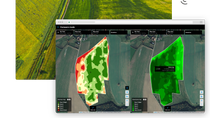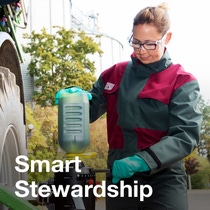Nature based solutions could account for up to
30%
of climate change mitigation.

Climate-Smart Agriculture
Agriculture
Biodiversity - the variety of living species in the natural world at the ecosystem, species, and genetic levels - is reducing at an alarming rate. The World Economic Forum (WEF) has identified biodiversity loss as one of the greatest global risks.
Nature based solutions could account for up to
30%
of climate change mitigation.
Crucially, climate change accelerates ecosystem degradation, which in turn increases the release of carbon into the atmosphere and reduces carbon sequestration. Fortunately, this can be reversed: Nature based solutions could account for up to 30% of climate change mitigation.
Over half of global GDP—around $43 trillion—depends on high functioning biodiversity, according to the WEF. Nowhere is this more true than in the Agriculture and Food sector. Flourishing biodiversity underpins ecosystem functions on planet Earth, among which are carbon and nutrient cycling, plant pollination and pest control. These in turn enable productive agriculture to a remarkable extent. For instance, 75% of agricultural crops, worth $2.4 trillion, rely on insect pollination.
According to the Intergovernmental Science-Policy Platform on Biodiversity and Ecosystem Services (IPBES), three of the five drivers of biodiversity loss are land use change, overexploitation of natural resources and climate change. This is precisely where our approach to “better yield” can make a difference. As we support farmers in implementing more holistic approaches to cropping systems – leveraging our innovation to maximize yields on available cropland, optimize resource use and promote carbon emissions reduction as well as carbon sequestration – we can mitigate these root causes of biodiversity loss without compromise on agricultural output.
As stewards of the land, farmers know the importance of striking the right balance between healthy, diverse ecosystems and growing high-quality food more efficiently. It allows them to be more resilient in the face of extreme weather conditions, reduces pressure to convert more land into farmland and preserves natural habitats.
We and other like-minded organizations are members of multiple World Business Council on Sustainable Development (WBCSD) working groups on Nature, Nature-based and Natural Climate Solutions. Their objectives are to develop sectoral roadmaps for nature-positive impact in collaboration with food and agriculture players, and to develop knowledge and exchange expertise for thought leadership that can ultimately drive nature-based carbon emissions reductions and removals within value chains, which contribute to global climate goals and member net zero targets. In addition, we are working very closely with all our peers in CropLife International as part of a forum where decisions are being made on goals and targets for conservation and sustainable use of biodiversity.
We are constantly developing innovative products, concepts, and partnerships to foster biodiversity protection in ways that are recognized and valued across value chains. Biodiversity is best safeguarded through joint efforts: depending on context and opportunities, we work with farmers, foundations, commercial partners, and other strategic stakeholders. Because specific focus issues of biodiversity and agriculture differ across regions, we lead several local initiatives tailored to specific local challenges, with a view to investing in both short- and long-term efforts that range from reforestation and pollinator gardens to education and the dissemination of Best Management Practices.
The impact of farming on biodiversity can only be improved if it is measured. We thus support transparency and the setting of clear targets to protect biodiversity through AgBalance®, BASF's tool for assessing sustainability in agriculture, of which biodiversity is a fundamental element.
Integrated biodiversity with
xarvio® FIELD MANAGER
The advanced xarvio® FIELD MANAGER crop optimization platform can integrate biodiversity protection into everyday farming activities. One of our notable contributions is the ability for farmers to include buffer zones, also known as biodiversity windows, such as water bodies, to safeguard our environment.
Xarvio® FIELD MANAGER combines and analyzes various information layers to identify the most suitable locations for the creation individual management zones within a field. Thanks to this, farmers can conveniently create buffer zones or biodiversity windows, such as flowering strips, through our innovative tool. By accurately pinpointing less productive areas using our biodiversity planner, growers can assess their suitability for different environmental management options.
Our digital farming solutions, including Zone Spray and Buffer Zones, empower farmers to apply crop inputs precisely where needed. With Zone Spray, weed maps guide farmers to apply products only in the right spots, helping reduce environmental impact. Meanwhile, our Buffer Zone solution utilizes high-resolution satellite imagery to automatically generate application buffers near protected areas, conforming to governmental regulations.
Learn more about xarvio® FIELD MANAGER's contributions: xarvio® FIELD MANAGER



